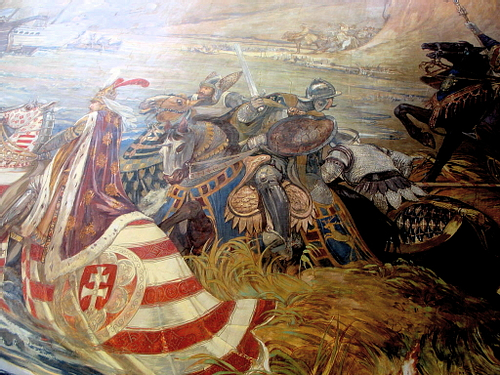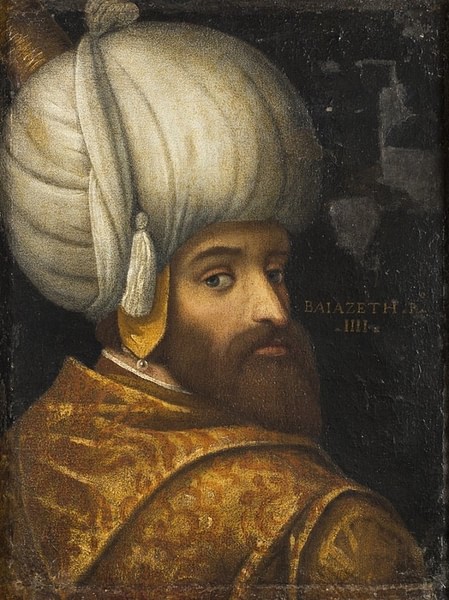
The Battle of Nicopolis in September 1396 CE, also known as the Nicopolis Crusade, was an attempt by French, Hungarian, and other European allies to curb the threat of the Ottoman Turks as they pressed ever westwards into Europe. Nicopolis in Bulgaria was the point of a dramatic and decisive defeat when an ill-disciplined and overconfident Crusader army was largely wiped out. Although smaller campaigns would follow in the 15th century CE, the disaster at Nicopolis brought an end to the long series of large-scale crusades which had seen huge Christian armies fight Muslim armies in western Asia and now Europe.
The Ottoman Turks
The leader of the Ottoman Turks who then controlled Anatolia was Bayezid I (r. 1389-1402 CE), also known as Yilderim (the Thunderbolt). Bayezid continued the successes of his father Murad I (r. 1362-1389 CE) in the Balkans and conquered Bulgaria. The Ottomans then set their sights on the Byzantine Empire and Hungary. Western European powers, and especially the Mediterranean's foremost maritime power, the Republic of Venice, were now seriously alarmed that trade in and through the Adriatic was in jeopardy. A decisive factor in the West's ability to respond to this threat was the recent conciliation between warring England and France. As a consequence, the whole of Europe was able to, as in the days of the very First Crusade of 1095-1102 CE, pull together and form a large multinational force.
Launching the Crusade
The early crusades had aimed to end the Muslim control of the Holy Land, but by the 14th century CE, the idea had long since been expanded to protecting Christians anywhere. Accordingly, the Muslim Ottomans presented a legitimate target for a crusade. The campaign was intended to weaken the Ottomans, restrict their expansive progress across Europe and relieve the pressure on Constantinople, capital of the Byzantine Empire and under Ottoman blockade since 1394 CE. The initial plan, made in the early 1390s CE, was to send two Crusader armies, first, there would be a smaller force led by John of Gaunt, Louis of Orleans, and Philip the Bold of Burgundy. They would then be followed by a larger army led by the King of France, Charles VI (r. 1380-1422 CE) and the King of England, Richard II (r. 1377-1399 CE). However, by early 1396 CE, the reality was all rather less grand. Both kings chose to remain at home to look after their own domains, and it was left to the son of Philip the Bold, John of Nevers, to lead a smaller-scale crusade, essentially a France-Burgundy operation which included some 700 knights. Still, the army as a whole was not a negligible one at around 10,000 men, and it received a welcome boost of 6,000 German troops under the command of Count Palatine Rupert and Eberhard, the Count of Katznellenbogen.
Fortunately for the Crusade, many more men were available in central and Eastern Europe. On arrival in Hungary in April 1396 CE, the western army was joined by an army of 70,000 under the command of King Sigismund of Luxembourg (r. 1387-1437 CE). The Crusader army now swelled to around 100,000 fighting men following the addition of perhaps 15,000 independent warriors from England, Italy, Poland, Spain, and Bohemia. To add to this land force, a joint fleet of Genoese, Venetian, and Knights Hospitaller ships sailed to the Black Sea and held station off the mouth of the River Danube.
Things now looked extremely promising for the Christians, at least in terms of sheer numbers, but Bayezid responded to the threat by withdrawing his troops from the siege of Constantinople and assembling an army of over 100,000 men. With two large armies in the field, victory on either side could be decisive to the future of the entire region.
Nicopolis & Defeat
The Crusader army enjoyed some military successes as it marched down the Danube valley, taking the small garrison towns of Vidin and Rahova and ruthlessly slaughtering the inhabitants, but this bright start came to a crushing end when it met Bayezid's main force just to the south of Nicopolis (Nikopol) in present-day Bulgaria. Nicopolis, located at the point where the main road through Bulgaria reached the Danube, was a major Ottoman stronghold perched on a hill and protected by a double wall of fortifications. Although lacking any siege engines, the Crusaders attacked the city anyway and, unsurprisingly, without much effect. A strategy of starving the city into submission was, by necessity, then adopted. A portion of the western fleet had arrived on the scene, but the blockade was proving to be as ineffective as the assault because Nicopolis had been well-stocked with supplies by its governor Dogan Bey.
Bayezid's army arrived via Thrace at the end of September and camped 5 km (3 miles) from Nicopolis. On the morning of the 25th of September, the two armies faced each other. Historians have been unable to ascertain what were the actual events of the battle, but it seems likely that, as with so many previous crusades, overconfidence and an underestimation of the enemy led to the westerners' downfall. Sigismund had urged caution and preferred a strategy of entrapment from prepared positions, but the Crusaders, as so often in the past, were intent on an all-out assault on the enemy in a single large offensive.

The Ottomans were an efficient fighting unit with specially trained troops such as the Janissary Guards, an elite corps of infantry archers formed from conscripted Christians who were given military training from childhood. Perhaps even more significant to this battle was the cream of the Ottoman army, the elite sipahis, a cavalry unit whose members were promised the right to estates and tax revenues for any success on the battlefield. Finally, the Ottoman army had a single leader, a stark contrast to the many different units and loyalties which made up the Crusader army.
When the French cavalry rashly charged the enemy infantry positions unsupported, which were protected by a line of sharpened stakes, the sipahis cavalry, until then kept in reserve, was able to take full advantage of the chaos amongst the Crusader troops caused by the French ill-discipline and the withdrawal of Sigismund's allies from Wallachia and Transylvania. The losses were heavy on both sides, but the Ottomans won a great victory. Over 10,000 captured westerners were slaughtered and many European nobles were taken prisoner, although King Sigismund was rescued from that fate by a group of Knights Hospitaller. John of Nevers was less fortunate, he was captured along with Philip of Artois, the Constable of France, and a number of other prominent French aristocrats. This group were only released following the payment of a huge ransom, said to have been around half a million francs.
Aftermath
Nicopolis was the last major Crusade and the defeat, along with the changing times in general, meant that Europe's nobility took a distinct lack of interest in any future religious campaigns against the Turks. The Ottomans soon tasted defeat themselves when Bayezid was taken captive in a battle against the Mongols near Ankara in 1402 CE and the Ottoman Turkish Empire was beset by the struggle amongst Bayezid's sons for its control. One of them was Mehmed I, and he would eventually take control in 1413 CE. Hungary continued the fight to stem the spread of the Ottomans, their brilliant general John Hunyadi winning victories in 1441 and 1442 CE, but the Varna Crusade of 1444 CE, the last major Christian offensive, was just as disastrous as Nicopolis. Constantinople fell to the Ottomans in 1453 CE, and they followed up that victory by conquering Wallachia, Albania, and Greece.





